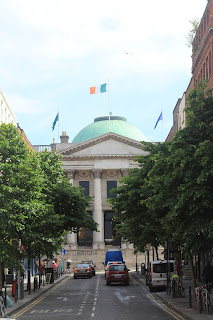After our Book of Kells experience, the rest of the day was ours to explore with no set times or itinerary. We embarked on a walking tour of Dublin, using a route suggested by the tourist information center. There were multiple bus tour options -- hop on/hop off and others with commentary -- but we find that exploring on foot gives us a better perspective and often leads to great discoveries you wouldn't necessarily see otherwise. The center of Dublin is often crowded, but very walkable.
Five things we encountered on our walking tour:
(1) The bosomy statue of Molly Malone shouting "Cockles & Mussels"
(2) Dublin City Hall -- the grand neoclassical building itself was built in 1779 as the Royal Exchange and became City Hall in 1852. We learned Dublin history and how the various merchant guilds were instrumental to the City's success in Dublin's early days. Meetings are still held in this building.
(3) Dublin Castle -- the seat of British rule in Ireland for over 700 years, it was the official residence of the viceroy who implemented the will of the British royalty.
(4) Old City Wall -- the original center of Dublin was originally a walled city like so many in Europe. Very little of the wall remains.
(5) St. Audoens Church -- this was a real gem. This is the oldest church in Dublin, dating back to the Norman era and constructed about 1200. It was once much larger, and we could see some of the ruins of the oldest sections. It's still an active church with services every Sunday at 10:00am.
Our legs (and our FitBits) got a real workout -- mine said we walked over 8 miles. While we were on fumes when we got back to the hotel, it's so worth the effort. You never know what you may encounter when you turn the next corner.



















































